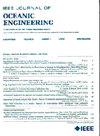Oceanic 3-D Thermohaline Field Reconstruction With Multidimensional Features Using SABNN
IF 5.3
2区 工程技术
Q1 ENGINEERING, CIVIL
引用次数: 0
Abstract
Aiming at the problems of missing data and outliers in ocean observations and incomplete characterization of thermohaline related features, a 3-D thermohaline reconstruction model of the ocean based on multisource data are proposed. Multisource data from remote sensing and Current and Pressure recording Inverse Echo Sounders were used to analyze the projection relationship between 12-D features, such as sea surface temperature, bidirectional propagation time, and seafloor current velocity, and the distribution of ocean temperature and salinity at different depths (10–1000 m). A Bayesian optimization algorithmic framework is used to evaluate and gradually remove uncertainty from currently known data during the iterative process by extracting network parameters from the approximate probability distribution. More informed decision making improves the stability of the iterative process and reconstruction. In addition, a self-attention mechanism is introduced to dynamically focus on the dependencies between features of different dimensions by calculating the correlation matrix between features at arbitrary locations, enabling the model to more comprehensively characterize the thermohaline distribution and its changes. A Self-attentive Bayesian neural network (SABNN) model is established through empirical regression. The reconstructed model is validated using observational data from the Gulf of Mexico, and the experimental results show that the SABNN model has a significant improvement in temperature and salinity reconstruction accuracy compared with other network models or methods, with the RMSE and基于SABNN的多维特征海洋三维温盐场重建
针对海洋观测数据缺失、异常值缺失以及热盐相关特征表征不完整等问题,提出了一种基于多源数据的海洋三维热盐重建模型。利用多源遥感数据和流压逆回声测深仪数据,分析了海面温度、双向传播时间、海底流速等12维特征之间的投影关系。采用贝叶斯优化算法框架,从近似概率分布中提取网络参数,在迭代过程中评估并逐步消除现有已知数据中的不确定性。更明智的决策制定提高了迭代过程和重建的稳定性。此外,引入自关注机制,通过计算任意位置特征之间的相关矩阵,动态关注不同维度特征之间的依赖关系,使模型能够更全面地表征温盐分布及其变化。通过经验回归建立了自关注贝叶斯神经网络(SABNN)模型。利用墨西哥湾观测数据对重建模型进行了验证,实验结果表明,与其他网络模型或方法相比,SABNN模型在温度和盐度重建精度上有显著提高,RMSE和$R^{2}$分别提高了29.68%、21.14%和31.01%、37.33%。
本文章由计算机程序翻译,如有差异,请以英文原文为准。
求助全文
约1分钟内获得全文
求助全文
来源期刊

IEEE Journal of Oceanic Engineering
工程技术-工程:大洋
CiteScore
9.60
自引率
12.20%
发文量
86
审稿时长
12 months
期刊介绍:
The IEEE Journal of Oceanic Engineering (ISSN 0364-9059) is the online-only quarterly publication of the IEEE Oceanic Engineering Society (IEEE OES). The scope of the Journal is the field of interest of the IEEE OES, which encompasses all aspects of science, engineering, and technology that address research, development, and operations pertaining to all bodies of water. This includes the creation of new capabilities and technologies from concept design through prototypes, testing, and operational systems to sense, explore, understand, develop, use, and responsibly manage natural resources.
 求助内容:
求助内容: 应助结果提醒方式:
应助结果提醒方式:


